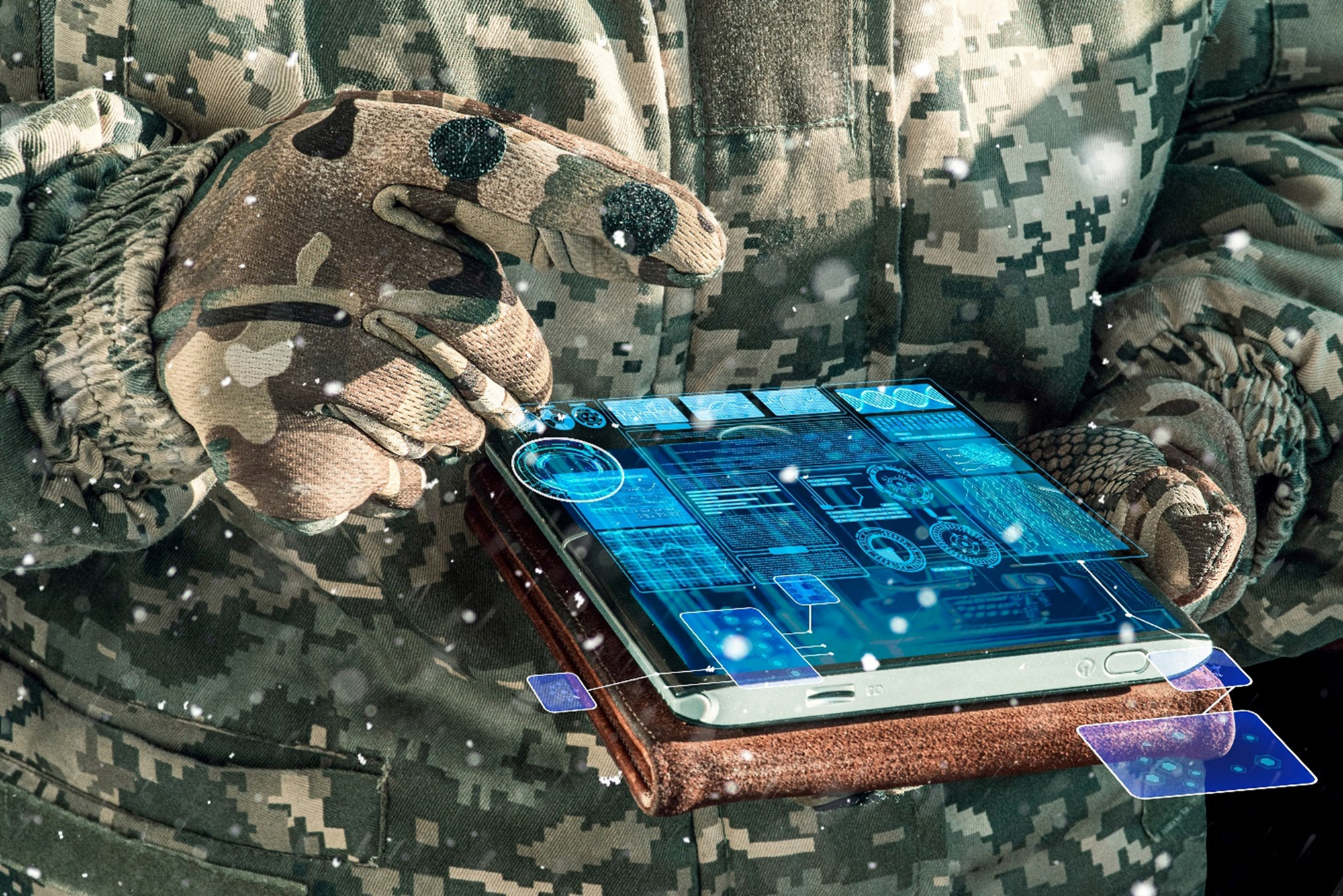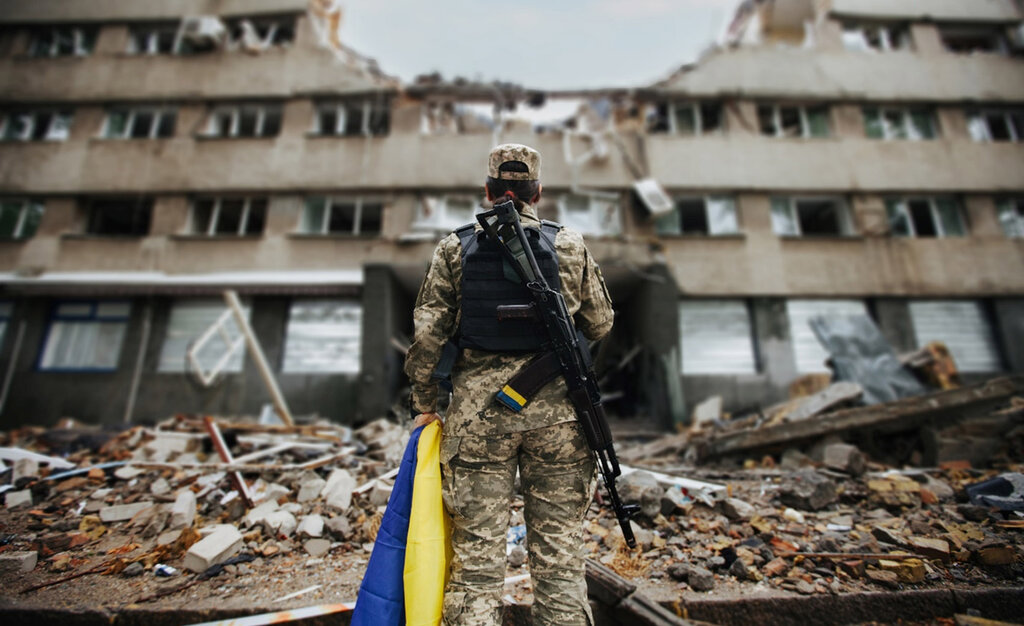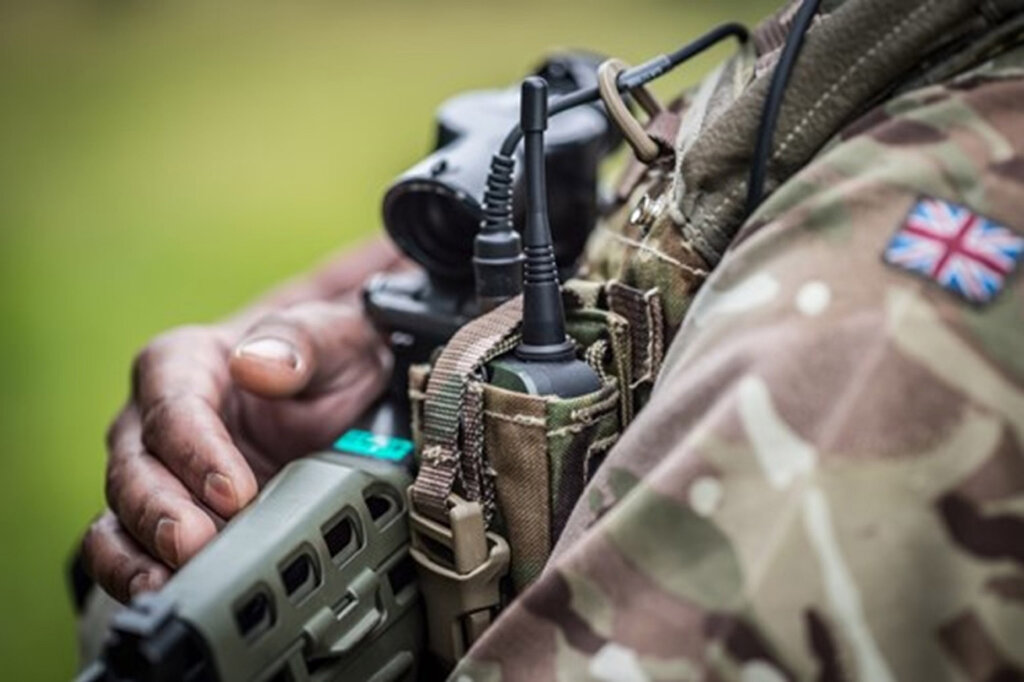Cover Story
Future soldier:
data driven decisions
The Western coalition must be attentive to the needs of Ukraine’s soldiers if they are to outmatch their adversaries in a new age of peer-on-peer combat. John Hill reports.

Commander uses AI on tablet computer with augmented reality. Credit: Shutterstock/TSViPhoto
Like much of the rest of the democratic world this year, the UK is heading toward a general election. With that in sight, the government will be pressured to offer more palatable headlines, instead of hailing a new “golden age of shipbuilding” while simultaneously cutting the Royal Navy’s overall ship count. Some might say that great platforms make Great Britain.
But with all the glitz and glamour of big planes, ships and armoured vehicles, investment in personnel and soldier systems may prove to be an area for sensible reflection as their role is evolving as they face more threats in the field.
The critical role of the soldier can be witnessed in Ukraine, where the world is tilting back toward what can be call a conventional, or peer and near-peer conflict. In this old, yet familiar context Ukrainian soldiers are learning lessons about high intensity warfare from which Western armies have grown so distant after two decades of counter-insurgency operations in Afghanistan and Iraq.
It is right for the Western coalition to extract what lessons they can from Ukraine when it comes to the new methods of war, but it is also vital that they learn what Ukrainian soldiers need on the organic level.
There are three aspects that repeatedly crop up when it comes to soldier performance: training, leveraging data, and operating faster.
Training days
At the heart of this juggling act that the modern soldier must now perform lies the growing use of autonomy. Ultimately, artificial intelligence (AI) and machine learning will ease the cognitive burden of personnel.
The digitisation of the modern battlefield has led to a heightened risk of ‘information overload’, whereby the decision-making of individual soldiers is hampered by the amount of data they are required to assimilate, interpret and respond to.
While you’re trying to be a jack of all trades, you become less effective at handling all of these things. Meanwhile the computer will sift through the data, process it and provide you with the immediate, simplest and actionable things as opposed to being bombarded with many things that are needed to track on a screen.
“If you can’t understand it, or if you can’t handle all these things as easily, then they’re not going to be as effective as if you handle less of them,” said Tristan Sauer, GlobalData defence analyst. “So, automation is a design characteristic, which can be applied to almost all of the value chains of the soldier systems.”
Various existing and future technologies are being adapted or developed to facilitate the integration of AI capabilities such as software defined radio, weapon optics, and uncrewed systems.
We are asking soldiers now to do more than they ever have before
GlobalData defence analyst Tristan Sauer
The implementation of this technology also provides opportunities for novel tactics and operations concepts to be employed, with streamlined C4ISR capabilities and manned-unmanned teaming enhancing the lethality, agility, situational awareness, and survivability of infantry units on the modern battlefield.
When Russian forces began their full-scale invasion of Ukraine in 2022 the troops were initially prepared with several days’ worth of rations. More than two years on the Russo-Ukrainian war continues as both sides try to take the initiative over the other in an enduring stalemate.
“When everyone has all the equipment – both the Ukrainians and the Russians have jets, air defence, armoured vehicles – what really makes the deciding factor is the quality of the people, the actual human soldier,” Sauer argued.
This comes down to Western training principles in which responsibility trickles down to the lower levels of infantry. This, Sauer says, is where “the divide comes between the quality of the Russian and Ukrainian forces.”
What used to be the remit of the Commander was to control all the drones for all these people. We now realise that is no longer tenable. When you take out that commander, you take out that drone and a hundred people do not have coverage. So, the idea is that every small squad needs to have its own batteries; it is important to promote self-sufficiency.

Ukrainian military woman with the Ukrainian flag in her hands on the background of an exploded house. Credit: Shutterstock/Alim Yakubov
The benefits of devolving capabilities to the lower echelons will only come about if alongside that there is a procedural change, or psychological change, in how you approach responsibility.
It is not just responsibility; it is also about treating the soldier as an asset too. Value on human lives prompts a greater strategic outlook. Conversely, the Russian war machine has derived its personnel from every level of society, sending them straight to the frontlines, from conscripted civilians to famously cutting deals with convicts.
“We are asking soldiers now to do more than they ever have before. They all need to be smarter and more complex, more technologically savvy, and fit. There’s just so much extra pressure on the modern soldier,” Sauer explained.
Sufficient training is an essential prerequisite that is already providing a military edge to Ukraine’s forces.
On 3 June 2024, the Institute for the Study of War posted an update noting that Ukrainian commanders are compensating for training difficulties that mobilisation has exacerbated by training newly deployed personnel on the frontline.
Their decision to do this before committing them to combat indicates that “the overall quality of Ukrainian forces will likely remain higher than that of the Russian forces in the near-to mid-term.”
Sauer added: “So because of that every soldier needs to be more educated. Every soldier requires more hours of training, more support.”
Data-driven decisions
With the emergence of new technologies, we can now begin to leverage data as efficiently as possible, even at a more minute level.
Sauer identified one futuristic area of focus called ‘biomonitoring’, whereby smart textiles are used to make personal protective equipment. These wearables provide a commander with real-time physical data for each individual soldier at the tactical level. All of this information is then fed into the wider control network.
“So instead of a thread just being a thread of wool, it’s a thread of wool that can also transfer data.”
If you can’t understand it, or if you can’t handle all these things as easily, then they’re not going to be as effective as if you handle less of them
GlobalData Defence Analyst Tristan Sauer
The US Army has been developing ‘Protein Catalysed Capture’ based receptors since around 2019. It is hoped that this technology could be integrated with a range of ‘smart’ equipment including eye-movement monitors, flexible displays/batteries, smart keychains, tissue-integrated biosensors (i.e. smart tattoos) and conventional wearables (i.e. smart watches).
“While there’s none of this in Ukraine, the point is Ukraine has shown that there is a big need for identifying battlefield trauma, particularly during high intensity warfare. There are more things that can kill you in different ways in Ukraine than there were in Iraq or Afghanistan, where there were IEDs, bullets and things," Sauer said.
Furthermore, data can be leveraged within a network, and this has been particular area of focus within industry in recent years.
Speaking with Global Defence Technology, John Dix, a Thales land communications representative and former solider, explained that “the sharing of information at the tactical edge is absolutely key, and that’s absolutely what the user is asking for, it’s what they need.”
Dix pointed to Thales’ SquadNet and Javelin mobile ad hoc network (MANET) radios as examples of British innovation in soldier systems. These systems provide a data network suitable for voice, data, and video traffic.

Image of British Army soldier using SquadNet radio communications system. Credit: Thales
“SquadNet, and also the Javelin radio, they’re both MANET radios that provide that interoperability, that sort of sharing of data, sharing of network information. So that is something that Thales are working on as a whole.”
SquadNet has enough range to work either within a tiered network structure or in a flat network configuration. For example, a full flat company network was demonstrated using 120 radios over 20km2 on the Salisbury Plain Training Area – and SquadNet’s network can be larger.
“You may be able to co-ordinate radio data in that tactical bubble for instance, but also it allows you to sort of back all that information further to a company level or even a battle group level,” suggested Dix.
“We are developing and building things with interoperability in mind. That goes hand in hand with other nations, for instance, so that is a key consideration as we go forward is we’re not just this insular, siloed organisation.”
$345m: Lynas Rare Earth's planned investment into Mount Weld.

Caption: The US Pentagon is seeking to reduce carbon emissions through a range of programmes, but will it go far enough? Credit: US DoD
Australia could be one of the main beneficiaries of this dramatic increase in demand, where private companies and local governments alike are eager to expand the country’s nascent rare earths production. In 2021, Australia produced the fourth-most rare earths in the world. It’s total annual production of 19,958 tonnes remains significantly less than the mammoth 152,407 tonnes produced by China, but a dramatic improvement over the 1,995 tonnes produced domestically in 2011.
The dominance of China in the rare earths space has also encouraged other countries, notably the US, to look further afield for rare earth deposits to diversify their supply of the increasingly vital minerals. With the US eager to ringfence rare earth production within its allies as part of the Inflation Reduction Act, including potentially allowing the Department of Defense to invest in Australian rare earths, there could be an unexpected windfall for Australian rare earths producers.
Total annual production


Phillip Day. Credit: Scotgold Resources